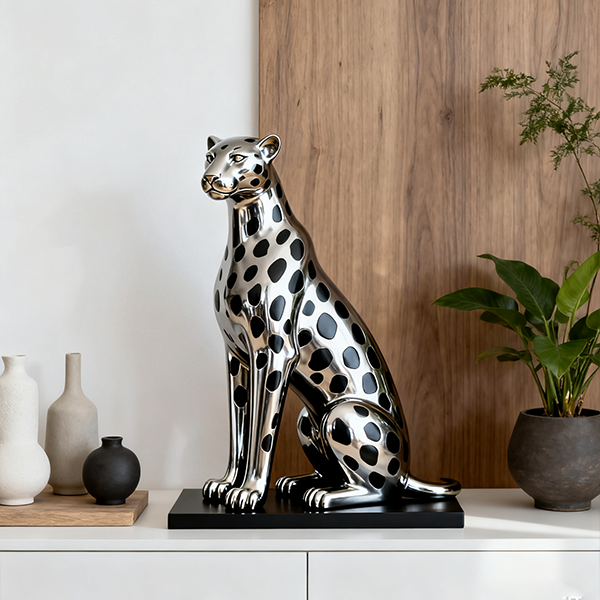In nature, leopards are known for their sleek bodies, sharp eyes, and wild energy. But when artists turn this animal into a sculpture, they don’t just copy a real leopard. Instead, they go through three simple steps—studying nature, simplifying the design, and adding meaning—to turn cold materials (like metal or resin) into a piece of art with soul.
1. Step 1: First, figure out the "key features" of a real leopard
You don’t need to remember every little detail—just focus on the things that make people go "that’s definitely a leopard" at a glance:
Body lines: A real leopard has "broad shoulders and a narrow waist." When it runs, its back curves into a smooth arc. Artists emphasize this when making sculptures—even if they don’t carve spots, people can still tell it’s a leopard just by looking at these lines.
Smart pose choices: If you want a calm sculpture (for example, to put in an entryway), choose a leopard in a sitting position—paws on the ground, tail wrapped around its body, looking steady. If you want one that feels powerful (for example, to put in a yard), pick the moment when it leaps—hind legs pushing off the ground, tail lifted to stay balanced, looking like it’s about to dash forward in the next second.

2. Step 2: Simplify based on the scenario
A real leopard has too many small details (such as fine fur and tiny claw tips). If you try to include all of them, the sculpture will actually look unappealing—so you need to make adjustments depending on where it will be placed.
Simplify details based on scenarios: For small home sculptures (e.g., entryway decorations), remove details like fur and claw tip textures, keeping only the head, body, and key spots to fit minimalist spaces. For large outdoor landscape sculptures, retain bold dynamic elements (such as the arc of a leap) and downplay minor details—this makes the sculpture more impactful when viewed from a distance.

Adapt the design language to styles: For a realistic style, use materials like bronze and stone to replicate textures, and optimize proportions to enhance visual impact. For a minimalist style, break the leopard down into geometric shapes (a round head + an elongated body) and use materials like resin or metal to fit modern homes. For a luxurious style, use brass with gilded leopard spots to blend wildness and elegance.

3. Infuse Soul: Give the Sculpture "Mood and Meaning"
A good leopard sculpture can convey emotions and carry ideas:
Scenario-based moods: Placing a "leopard sitting with head held high" (made of copper/stone) in the entryway feels like a guardian, bringing a sense of security. Putting a "leopard gazing downward" (made of matte metal) in the study uses its focused posture to suggest staying calm and focused on work.
Cultural and conceptual elements: New Chinese-style designs add cloud patterns and coin-shaped bases to incorporate the meaning of "protection and good fortune". Modern-style pieces feature "running leopards with broken lines" (made of transparent resin + metal), symbolizing breaking free from constraints and matching the mindset of young people.
The "transformation" of a leopard sculpture, in essence, turns the beauty of nature into art that fits daily life. Every piece is a "life companion" that suits the space and conveys emotions—not just a simple copy.
Contact: Mr.Li
Phone: 0086-15188960033
E-mail: sale2@tongyundiaosu.com
Whatsapp:008615188960033
Add: Changucheng Industrial Zone,Tang County,Baoding City,Hebei Province,China.
We chat
